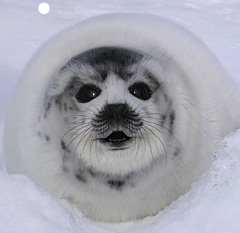 |
 |
 |
 Editorials | Environmental | June 2007 Editorials | Environmental | June 2007  
Seal Hunt Flouts Laws, Mexican Group Says
 Martin Mittelstaedt - The Globe and Mail Martin Mittelstaedt - The Globe and Mail
go to original


| | The group claims that few hunters check to see if all the animals they club or shoot are dead or unconscious before skinning them. The main test of this is to poke the seals in the eye to see if there is a blinking reflex. |
The Canadian federal government is ignoring wildlife conservation laws and permitting violations of the Criminal Code's animal welfare provisions in the annual seal hunt, a major Mexican environmental group contends.

The Mexican Centre for Environmental Law says Ottawa's failure to enforce conservation and animal-cruelty laws in the seal hunt, the world's largest marine mammal hunt, is so extensive it has asked the Commission for Environmental Co-operation, the NAFTA environmental watchdog, to launch a formal investigation.

In a filing submitted yesterday to the Montreal-based CEC, the group also alleges that Ottawa is allowing such high numbers of seals to be killed each year, including regular quota overruns, that it could deplete the population and cause "serious or irreversible damage to the northwest Atlantic ecosystem."

When Canada, the United States and Mexico set up NAFTA's environmental watchdog in the mid-1990s, the thinking was that Mexico, with its spotty environmental record and status as the poorest of the three trade partners, would need the most policing on pollution laws.

But as this new filing shows, conservationists at the group think the Canadian government needs international oversight to make it adhere to environmental rules and good conservation practices.

The CEC doesn't have legal power to fine countries, but can issue reports known as factual records that review whether governments are failing to enforce their laws effectively, with the hope that adverse publicity will force better compliance.

If the CEC decides to investigate, it will be one of the first independent reviews of Canadian claims that it is following good conservation management practices when it comes to seal populations, and that the hunt - which involves the clubbing, shooting, and skinning on ice floes of young seals - is conducted with the minimum of cruelty.

Earlier this year, Fisheries Minister Loyola Hearn announced that sealers would be allowed to kill 270,000 animals, and he put in place new measures to prevent hunters from exceeding their quotas. He also said the department would try to get a new estimate of the seal population by next year, rather than 2009 as previously planned.

The Foreign Affairs Department was unable to comment on the group's filing yesterday.

The Mexican group, known in Spanish as the Centro Mexicano de Derecho Ambiental, or CEMDA, compiled a 20-page analysis of why it believes Ottawa is failing in its management of the hunt.

Among its concerns are that the government has allowed more animals to be killed, up to 350,000 in recent years, than the sustainable yield of 250,000 estimated by federal scientists. In four of the five years from 2002 to 2006, the quota was exceeded.

The Mexican group also says there is considerable scientific uncertainty about the actual size of the seal population. While the fisheries department estimates it is around 5.5 million, the actual number could be over counted or undercounted by as much as 2 million, given the difficulties of figuring out an animal population over such a wide area of open water.

If the actual number is at the low end of the range, and global warming continues to undermine the sea ice that seals need to give birth to pups, the group said Ottawa will be guilty of serious mismanagement.

The group also contended that the hunt violates Criminal Code provisions against animal cruelty because few hunters check to see if all the animals they club or shoot are dead or unconscious before skinning them.

The main test of this is to poke the seals in the eye to see if there is a blinking reflex. The group cited one study that found 79 per cent of sealers failed to conduct this test. | 
 | |
 |



